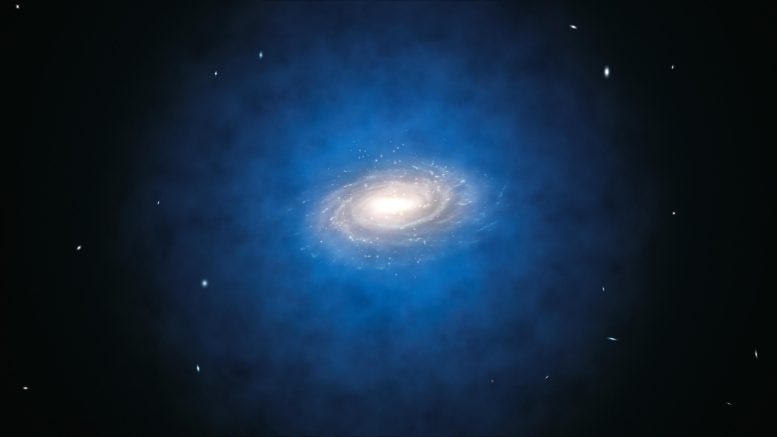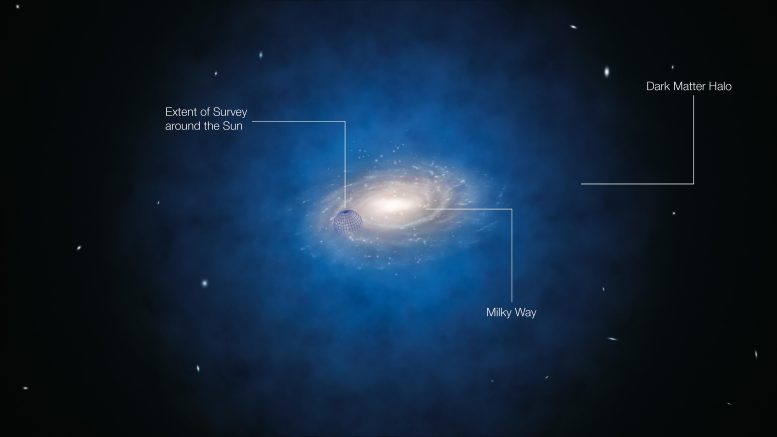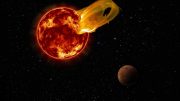
This artist’s impression shows the Milky Way galaxy. The blue halo of material surrounding the galaxy indicates the expected distribution of the mysterious dark matter, which was first introduced by astronomers to explain the rotation properties of the galaxy and is now also an essential ingredient in current theories of the formation and evolution of galaxies. New measurements show that the amount of dark matter in a large region around the Sun is far smaller than predicted and have indicated that there is no significant dark matter at all in our neighborhood. Credit: ESO/L. Calçada
A new study is going against widely believed theories about dark matter. While using telescopes including the MPG/ESO 2.2-meter telescope at ESO’s La Silla Observatory, astronomers were able to map the motion of hundreds of stars around the sun, calculating the mass of material in the vicinity and finding no evidence of dark matter.
The most accurate study so far of the motions of stars in the Milky Way has found no evidence for dark matter in a large volume around the Sun. According to widely accepted theories, the solar neighborhood was expected to be filled with dark matter, a mysterious invisible substance that can only be detected indirectly by the gravitational force it exerts. But a new study by a team of astronomers in Chile has found that these theories just do not fit the observational facts. This may mean that attempts to directly detect dark matter particles on Earth are unlikely to be successful.
A team using the MPG/ESO 2.2-meter telescope at ESO’s La Silla Observatory, along with other telescopes, has mapped the motions of more than 400 stars up to 13,000 light-years from the Sun. From this new data they have calculated the mass of material in the vicinity of the Sun, in a volume four times larger than ever considered before.
“The amount of mass that we derive matches very well with what we see — stars, dust, and gas — in the region around the Sun,” says team leader Christian Moni Bidin (Departamento de Astronomía, Universidad de Concepción, Chile). “But this leaves no room for the extra material — dark matter — that we were expecting. Our calculations show that it should have shown up very clearly in our measurements. But it was just not there!”
Dark matter is a mysterious substance that cannot be seen, but shows itself by its gravitational attraction for the material around it. This extra ingredient in the cosmos was originally suggested to explain why the outer parts of galaxies, including our own Milky Way, rotated so quickly, but dark matter now also forms an essential component of theories of how galaxies formed and evolved.
Today it is widely accepted that this dark component constitutes about 80% of the mass in the Universe [1], despite the fact that it has resisted all attempts to clarify its nature, which remains obscure. All attempts so far to detect dark matter in laboratories on Earth have failed.
By very carefully measuring the motions of many stars, particularly those away from the plane of the Milky Way, the team could work backward to deduce how much matter is present [2]. The motions are a result of the mutual gravitational attraction of all the material, whether normal matter such as stars, or dark matter.
Astronomers’ existing models of how galaxies form and rotate suggest that the Milky Way is surrounded by a halo of dark matter. They are not able to precisely predict what shape this halo takes, but they do expect to find significant amounts in the region around the Sun. But only very unlikely shapes for the dark matter halo — such as a highly elongated form — can explain the lack of dark matter uncovered in the new study [3].
The new results also mean that attempts to detect dark matter on Earth by trying to spot the rare interactions between dark matter particles and “normal” matter are unlikely to be successful.
“Despite the new results, the Milky Way certainly rotates much faster than the visible matter alone can account for. So, if dark matter is not present where we expected it, a new solution for the missing mass problem must be found. Our results contradict the currently accepted models. The mystery of dark matter has just become even more mysterious. Future surveys, such as the ESA Gaia mission, will be crucial to move beyond this point.” concludes Christian Moni Bidin.
More information
This research was presented in a paper, “Kinematical and chemical vertical structure of the Galactic thick disk II. A lack of dark matter in the solar neighborhood,” by Moni-Bidin et al. to appear in The Astrophysical Journal.
Reference: “Kinematical and chemical vertical structure of the Galactic thick disk II. A lack of dark matter in the solar neighborhood” by C. Moni Bidin, G. Carraro, R. A. Méndez and R. Smith, 1 May 2012, The Astrophysical Journal.
DOI: 10.1088/0004-637X/751/1/30
Notes
- According to current theories, dark matter is estimated to constitute 83% of the matter in the Universe with the remaining 17% in the form of normal matter. A much larger amount of dark energy also seems present in the Universe, but is not expected to affect the motions of the stars within the Milky Way.
- The observations were made using the FEROS spectrograph on the MPG/ESO 2.2-meter (7.2-foot) telescope, the Coralie instrument on the Swiss 1.2-meter Leonhard Euler Telescope, the MIKE instrument on the Magellan II Telescope and the Echelle Spectrograph on the Irene du Pont Telescope. The first two telescopes are located at ESO’s La Silla Observatory and the latter two telescopes are located at the Las Campanas Observatory, both in Chile. A total of more than 400 red giant stars at widely differing heights above the plane of the galaxy in the direction towards the south galactic pole were included in this work.
- Theories predict that the average amount of dark matter in the Sun’s part of the galaxy should be in the range 0.4-1.0 kilograms (0.9-2.2 pounds) of dark matter in a volume the size of the Earth. The new measurements find 0.00±0.07 kilograms (0.15 pounds) of dark matter in a volume the size of the Earth.










Maybe the fact that the sun is holding together may give some thought to the matter.
Dark matter is only an extra-galactic source and never intra-galactic or extra-stellar in location. So naturally Dark matter cannot be found around the Sun or any of its planets going around. Dark matter causes galactic seperation which makes the galaxies to flee at an enormous speed comparable to speed of light . Moreover Dark Matter exerts anti-gravitational effect on its surrounding galaxies which is causing expansion of universe. Its gravitational lensing effect is also due to splitting of light beam from distant galaxies through its anti-gravitational property. Probably Dark Matter could be found inside the black holes balancing the gravitational collapsing of stars. Bits of Dark matter could also be probably found inside Sun or other stars for holding its geometry of sphericity. It could be probably giving a core to these stars around which helium fusion reactor is going on , just as we think gaseous ionic core for terrestrial spherical planets causing terrestrial magnetism. Sun`s magnetism is easy to think since whole of chromosphere is ionic in nature.Thank You.
Wow, erudite readers! (not) And not surprising that Madanagopal name starts with “mad”. Nothing of any sense at all! And Pete, really, why didn’t you just say that the rocking of your little plastic pony should shed some light on the matter? Goofballs in SPAAAAAAAAAAAAAAAAAAACCCE!
No, this is a really interesting result because it complicates things. No nice smooth billowing dark matter centred on the galactic centre. Dang! Maybe dark matter does have some repulsive interaction with baryonic matter??? But at some distance attracts? Weird. Apparently, we won’t be mining it any time soon. I can’t help but always think of ether when it comes up…elusive, unlikely, but there none the less.
Sorry , Peter Buddy !! You first finish your kindergarten classes and school studies to understand Matter and Dark Matter concepts. OH! My name suggests that I am a Matter- Dark Matter exponent (Ma-Da) in as much as I am a theoretical physicist. You need a lot of brain to understand theoretical physics concepts which I hope that that your head would not hold. Dark Matter is anisotropic in the sense that it is not spread evenly in the cosmos. Gravitation is attractive force only as far as light matter is concerned which is why all the 4% real matter is condensed to form the galaxies and stars which we see. Dark Matter is Boson like (You know about bosons ? Study with the help of your teacher about W+, W- and Z Bosons and try to understand them. Bosons will fall one over the other in the same space like your Laser beam. But…. ! Bosons are massive. You know E=mc^2?
For getting mass it need not be a particle or lepton. That is why I had suggested that near Sun it would not be available and inside the core of the galaxy and black hole the Dark matter can make them spin into spiral and globular galaxies for which ordinary gravity alone will not suffice. Study Physics first and then try to comment.
A bit of Dark Matter Physics is here to elucidate. We know that like poles repel and unlike poles attract in electricity. Thus there are both attractive and repulsive forces in electricity and magnetism but of the same magnitude by inverse square law, q1*q2/d^2 or m1*m2/d^2 as the case may be. The same inverse square law applies to gravitation also, viz., m1*m2/d^2 but we have not come across positive and negative of masses. The rule follows a different treatment here viz., like matters attract and unlike matters repel, being opposite of vectors. As for as Matter is concerned both matter and anti-matter correspond to the same category of light matter and so they attract each other under gravitation to form stars and galaxies of the visible universe. The opposite of light matter is only Dark Matter which is Bosonic in composition whereas the light matter is corpuscular in texture. So, Dark Matter and light matter will repel each other. Thus light matter attract each other gravitationally to form galaxies and Dark Matter attract their same kind and form lumps of Dark Matter in the cosmos. That is why we get expansion of Universe where huge masses of Dark Matter which are clumped together can drive away light matter viz., galaxies apart at fantastic speeds. The repulsion in gravity can account for the gravitational lensing effect of distant galaxies by Dark Matter also, deflecting light. If a bit of Dark Matter is trapped inside a galaxy, its driving force is sufficient to spin the galaxies into globular and spiral galaxies. Any small bit of Dark Matter would be driven away by Sun incidentally by the same reasoning. A great deal of research has got to be done yet in this field to know the secrets of nature further. Thank You.
The real, simple picture on dark matter around the Sun, or elsewhere, is at:
New cosmology explains CMBR, Red Shift, Dark Matter — dumps Big Bang, Expanding Universe, Dark Energy.
Moreover, “The Oort Soup as the real origin of Cosmic Microwave Background Radiation “, at:
contains a new technique for identifying components of Dark Matter:
“A new technique for Oort-Soup astronomers
…
The reasoning here suggests another technique for detecting distant Oort-Soup objects. If you look again at the TOS1 spectrum curve, it tails off smoothly to the right. This is the area of warmer objects, closer to stars. ”
David Noel
I know this is old but why do these discussions always end up being a flamewar between an arrogant student who has no idea what he is talking about despite a physics degree (Extra-galactic? Nope. Used to explain rotation curves of galaxies, so very much intra-galactic) and some random who has a new theory of Physics which seeks to reinvent the wheel at every juncture. And both react to each other with ad-hominem attacks. Pure unadulterated ego-boosting stupidity from both sides. Ugh.